|
|
CAMBODIA: 25.01. - 06.02.05
Route: Stung Treng, Kompong Cham, Kompong Thom, Seam Reap, Poipet
Distance Bike: 956 Km Ascent (in total): 600m
|
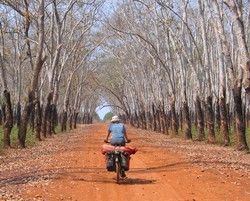 Preface: One of the most cruel civil wars
of the 20th century just stopped some years ago in Cambodia. Thatīs
why we were really surprised, that the Khmer (citizens of Cambodia)
seemed to bee really happy and relaxed. Although you can see and
feel the bad results of tourism, we hope that the Khmer are not
going to sell their friendly behavior for some dollars. Because
of the spare populated country and the ricefields, camping was no
problem. But because of the heat and the bad road conditions, Cambodia
was quite tough for us. More than 400 Km we had to cycle on unpaved
roads. Preface: One of the most cruel civil wars
of the 20th century just stopped some years ago in Cambodia. Thatīs
why we were really surprised, that the Khmer (citizens of Cambodia)
seemed to bee really happy and relaxed. Although you can see and
feel the bad results of tourism, we hope that the Khmer are not
going to sell their friendly behavior for some dollars. Because
of the spare populated country and the ricefields, camping was no
problem. But because of the heat and the bad road conditions, Cambodia
was quite tough for us. More than 400 Km we had to cycle on unpaved
roads.
|
| |
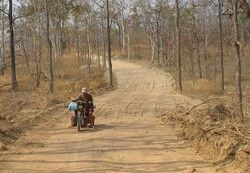 Great roads: The first 320 km in Cambodia
we had to cycle nearly all the time on unpaved roads. The conditon
of the roads varied from perfect gravel roads to sandy courses. Especially
the road conditions between Stung Treng and Kratie were really bad.
Because of plenty roadworks, we had to take some small sandy detours
through the forests. While the cars managed somehow to drive througt
the sandy parts, we had to push our bikes. It is really great to push
a 80 Kg heavy bicycle (with the trailer), at 35°C in the shadow, throuh
deep sand. Of course we also had some strong head wind. We are also
going to remember the stage between Chlong and Kompong Cham for quite
a while. As soon as the gravel roads became quite good, the jeep drivers
started to drive very fast. After a Jeep had passed, we had to cycle
in a cload of dust for several minutes. Great roads: The first 320 km in Cambodia
we had to cycle nearly all the time on unpaved roads. The conditon
of the roads varied from perfect gravel roads to sandy courses. Especially
the road conditions between Stung Treng and Kratie were really bad.
Because of plenty roadworks, we had to take some small sandy detours
through the forests. While the cars managed somehow to drive througt
the sandy parts, we had to push our bikes. It is really great to push
a 80 Kg heavy bicycle (with the trailer), at 35°C in the shadow, throuh
deep sand. Of course we also had some strong head wind. We are also
going to remember the stage between Chlong and Kompong Cham for quite
a while. As soon as the gravel roads became quite good, the jeep drivers
started to drive very fast. After a Jeep had passed, we had to cycle
in a cload of dust for several minutes. |
| |
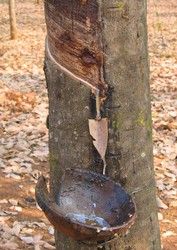 Rubber Forest: Cambodia
also has a big rubber industrie. Rubber is produced from tress. To
get the rubber you have to cut the trees diagonal and place a leaf
of the tree at the bottom of the cut, so that the milky juice can
flow in a small bowl (half coconut). To avoid, that the rubber plantations
become a jungle, there are many people who take care of them. There
are no bushes in the plantations an even the leaves are raked away
and burned. Rubber Forest: Cambodia
also has a big rubber industrie. Rubber is produced from tress. To
get the rubber you have to cut the trees diagonal and place a leaf
of the tree at the bottom of the cut, so that the milky juice can
flow in a small bowl (half coconut). To avoid, that the rubber plantations
become a jungle, there are many people who take care of them. There
are no bushes in the plantations an even the leaves are raked away
and burned. |
| |
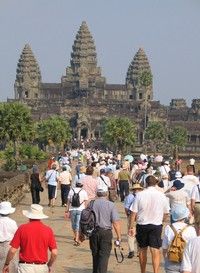 Tempels of Angkor: The Tempels
of Angkor are still reminders of the kingdom of the Khmer. Between
the 9th and the 13th century this dynasty of godkings ruled the country
from their capital Angkor, 7 Km north of todays Seam Reap. The Khmer
had good trade connecions to India, and so they brought Hinduism to
Angkor. The most worshiped god was the Hindugod Shiva, respected from
the godkings as the great protector of their country. To worship Shiva,
and of course to glorify also themselfes, the Khmerkings built some
huge Temples. After their kingdom was destroyed, Angkor lost its power
and got lost, until the French historian Henri Mouhout found it in
1863. From now on the Jungletemples became the intrest of many historians
until it became a tourist attraction. Tempels of Angkor: The Tempels
of Angkor are still reminders of the kingdom of the Khmer. Between
the 9th and the 13th century this dynasty of godkings ruled the country
from their capital Angkor, 7 Km north of todays Seam Reap. The Khmer
had good trade connecions to India, and so they brought Hinduism to
Angkor. The most worshiped god was the Hindugod Shiva, respected from
the godkings as the great protector of their country. To worship Shiva,
and of course to glorify also themselfes, the Khmerkings built some
huge Temples. After their kingdom was destroyed, Angkor lost its power
and got lost, until the French historian Henri Mouhout found it in
1863. From now on the Jungletemples became the intrest of many historians
until it became a tourist attraction. |
| |
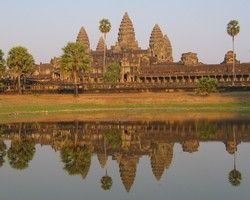 Angkor Wat: The greatest attraction of Angkor
is "Angkor Wat", meaning the "Tempel of Angkor". Angkor Wat is the
biggest religious building ever made by mankind. Godking Suryavarman
built this temple at the beginning of the 12th century to worship
his major dejity Vishnu. Like the Hindu universe, seen in Mt. Meru
in India, Angkor Wat is constructed like a mountain. This temple mountain
has three stages, each surrounded by a galery. On the top of the mountain
are 5 temples, with the central temple being situated 55m above ground
level. Very interesting is a 800m long stone carving situatet in the
gallery on the first level. The stone carvings show some scenes from
the hindu tradition. Even today, Angkor Wat is still a place of religious
worship. Because at the end of the 12th century Buddhism started to
become more popular in Angkor, many of the Hindu sculptures were replaced
with Buddha statues. Each evening after sunset, many local people,
mainly Buddhists, come to Angkor Wat for their puja (religious ceremony). Angkor Wat: The greatest attraction of Angkor
is "Angkor Wat", meaning the "Tempel of Angkor". Angkor Wat is the
biggest religious building ever made by mankind. Godking Suryavarman
built this temple at the beginning of the 12th century to worship
his major dejity Vishnu. Like the Hindu universe, seen in Mt. Meru
in India, Angkor Wat is constructed like a mountain. This temple mountain
has three stages, each surrounded by a galery. On the top of the mountain
are 5 temples, with the central temple being situated 55m above ground
level. Very interesting is a 800m long stone carving situatet in the
gallery on the first level. The stone carvings show some scenes from
the hindu tradition. Even today, Angkor Wat is still a place of religious
worship. Because at the end of the 12th century Buddhism started to
become more popular in Angkor, many of the Hindu sculptures were replaced
with Buddha statues. Each evening after sunset, many local people,
mainly Buddhists, come to Angkor Wat for their puja (religious ceremony). |
| |
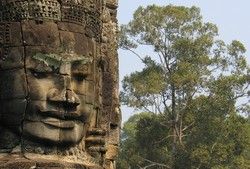 Bayon: From outside, this temple
mountain looks like a big stone pile. Once inside of the temple, it
is hard to stop admiration. The temple was bulit in the 12th century
from Jayavarman VII as his state temple in the middle of the city
Angkor. Instead of creating their own temples, many of the successors
of Jayavarman VII just rebuilt the Bayon Temple. So today you find
a complex building with passages, galleries, chambers, towers and
stairs. Very impressive are the many towers (originaly 54, now 37
left) of the temple. They have huge faces on each side. In total 216
huge stone faces are still watching all the tourists. Bayon: From outside, this temple
mountain looks like a big stone pile. Once inside of the temple, it
is hard to stop admiration. The temple was bulit in the 12th century
from Jayavarman VII as his state temple in the middle of the city
Angkor. Instead of creating their own temples, many of the successors
of Jayavarman VII just rebuilt the Bayon Temple. So today you find
a complex building with passages, galleries, chambers, towers and
stairs. Very impressive are the many towers (originaly 54, now 37
left) of the temple. They have huge faces on each side. In total 216
huge stone faces are still watching all the tourists. |
| |
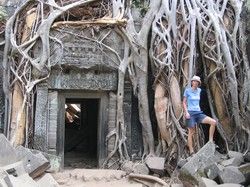 Ta Prohm: Ta Prohm is a Buddhist
monastery (built at the end of the 12th century from Jayavarman VII),
is one of the most famous attractions of Angkor. Thanks to the wisdom
of some french historians, the temple is still quite in the same condition
like it was when it was found. There are huge trees betwenn the walls
and the buildings, and many building are already collapsed or are
going to collapse soon. You have the feeling to bee in a sequence
of a Indiana Jones movie. Recently some parts of the movie Thumbs
Rider were shot in Ta Prohm. No wonder, because behind each corner
there is something new to discover; walls and buildings broke down
below a huge tree, huge roots supporting walls here and destroying
it there or a small figure well hidden between some roots. Ta Prohm: Ta Prohm is a Buddhist
monastery (built at the end of the 12th century from Jayavarman VII),
is one of the most famous attractions of Angkor. Thanks to the wisdom
of some french historians, the temple is still quite in the same condition
like it was when it was found. There are huge trees betwenn the walls
and the buildings, and many building are already collapsed or are
going to collapse soon. You have the feeling to bee in a sequence
of a Indiana Jones movie. Recently some parts of the movie Thumbs
Rider were shot in Ta Prohm. No wonder, because behind each corner
there is something new to discover; walls and buildings broke down
below a huge tree, huge roots supporting walls here and destroying
it there or a small figure well hidden between some roots. |
| |
| Food: In the meanwhile we are used to many types of food,
but the condition of the markets in Cambodia was very scaring even
for us. Already in Egypt and India, we had to accept bad hygienic
conditions, but it was never as awful as in Cambodia. On the markets
for example the meat was presented on the floor or on some wooden
boards, with a dog with louses sleeping just some centimeters next
to it. Also the condition of some street restaurants was quite awful.
Quite often we saw the owner of the restaurant staying in his own
rubbish up to his ankles, not to talk about all the rubbish behind
his food stall. Although not being fussy with food, in Cambodia we
sometimes were really concerned. |
| |
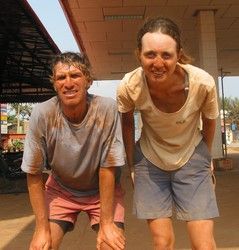 Quite dirty: Normally we expected to have
a good road from Angkor to Thailand, but it came different. The distance
from Seam Reap to the border was about 140 Km and after 35 Km we again
ha a "beautiful" sandy gravel road. The 70Km long stage was not really
difficult, but there was much more traffic. Constantly a jeep, a truck
or a bus overtook us, leaving us in a big cloud of dust. Sometimes
we disappeared one hour in a huge cloud of dust. Hard to imagine that
many people are living next to the road. After 6 hours tough cycling
we came back to the paved road. We never had been so dirty on our
journey (even not in Egypt and India). We went to the next petrol
station and started a big cleaning and we were at least able to wash
the first layer of the red dust from our faces. Quite dirty: Normally we expected to have
a good road from Angkor to Thailand, but it came different. The distance
from Seam Reap to the border was about 140 Km and after 35 Km we again
ha a "beautiful" sandy gravel road. The 70Km long stage was not really
difficult, but there was much more traffic. Constantly a jeep, a truck
or a bus overtook us, leaving us in a big cloud of dust. Sometimes
we disappeared one hour in a huge cloud of dust. Hard to imagine that
many people are living next to the road. After 6 hours tough cycling
we came back to the paved road. We never had been so dirty on our
journey (even not in Egypt and India). We went to the next petrol
station and started a big cleaning and we were at least able to wash
the first layer of the red dust from our faces. |
|
|
I
BOOKLET
available
for
DONATION!

50pages, 80 b/w photos, background
infos, stories, ...
Just send your donation
to our
Pay
Pal account: nadinepuschkasch@yahoo.de
and email us your post
address and we´ll send it to you.
|
| |
| |
|
Like to place your Ad here?
Just e-mail to:
martinlunz@yahoo.de
|
| |
| |
|
You
liked our website and like to contribute?
Our Pay
Pal account is: nadinepuschkasch@yahoo.de
|
|
| |
|
